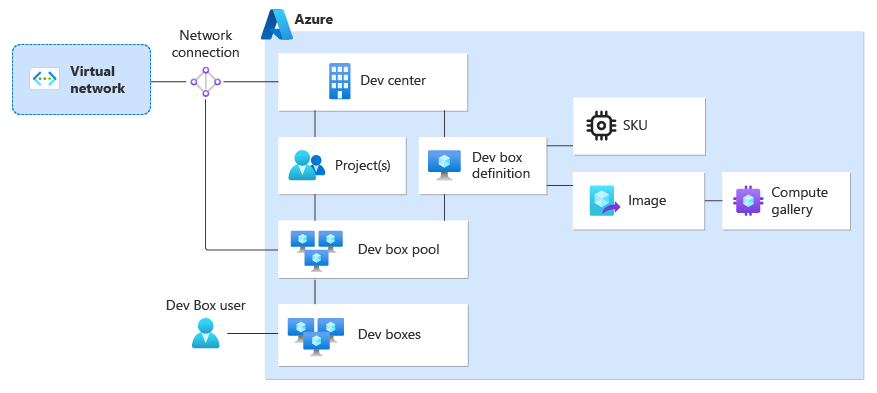Key concepts for Microsoft Dev Box
This article describes the key concepts and components of Microsoft Dev Box to help you set up the service successfully.
Microsoft Dev Box gives developers self-service access to preconfigured and ready-to-code cloud-based workstations. You can configure the service to meet your development team and project structure, manage security, and network settings to access resources securely. Different components play a part in the configuration of Microsoft Dev Box.
Microsoft Dev Box builds on the same foundations as Azure Deployment Environments. Deployment Environments provides developers with preconfigured cloud-based environments for developing applications. The services are complementary and share certain architectural components, such as a dev center or project.
This diagram shows the key components of Dev Box and how they relate to each other. You can learn more about each component in the following sections.
For more in-depth information about the Microsoft Dev Box architecture, see the architecture overview article.
Dev center
A dev center is a collection of Projects that require similar settings. Dev centers enable platform engineers to:
- Manage the images and SKUs available to the projects by using dev box definitions.
- Configure the networks that the development teams consume by using network connections.
Azure Deployment Environments also uses dev centers to organize resources. An organization can use the same dev center for both services.
Catalogs
The Dev Box quick start catalog contains tasks and scripts that you can use to configure your dev box during the final stage of the creation process. Microsoft provides a quick start catalog that contains a set of sample tasks. You can attach the quick start catalog to a dev center to make these tasks available to all the projects associated with the dev center. You can modify the sample tasks to suit your needs, and you can create your own catalog of tasks.
To learn how to create Dev Box customizations, see Microsoft Dev Box team customizations.
Project
In Dev Box, a project represents a team or business function within the organization. Each project is a collection of pools, and each pool represents a region or workload. When you associate a project with a dev center, all the settings at the dev center level are applied to the project automatically.
Each project can be associated with only one dev center. Dev managers can configure the dev boxes available for a project by specifying the dev box definitions that are appropriate for their workloads.
To enable developers to create their own dev boxes, you must provide access to projects for developers by assigning the Dev Box User role.
You can configure projects for Deployment Environments and projects for Dev Box resources in the same dev center.
Dev box definition
A dev box definition specifies a source image and size, including compute size and storage size. Select a source image from Azure Marketplace or a custom image from your own Azure Compute Gallery instance. Dev Box supports client editions of Windows 10 and Windows 11. You can use dev box definitions across multiple projects in a dev center.
Network connection
IT administrators and platform engineers configure the network they use for dev box creation in accordance with their organizational policies. Network connections store configuration information, like Active Directory join type and virtual network, that dev boxes use to connect to network resources.
Dev Box supports two types of network connections:
- Microsoft-hosted network connection - Microsoft manages the network infrastructure and related services for your dev boxes.
- Azure network connection - You manage the network infrastructure and related services for your dev boxes.
- If your dev boxes need to connect exclusively to cloud-based resources, use native Microsoft Entra ID join.
- If your dev boxes need to connect to on-premises resources and cloud-based resources, use hybrid Microsoft Entra ID join.
To learn more about native Microsoft Entra join and Microsoft Entra hybrid join, see Plan your Microsoft Entra device deployment.
Azure regions for Dev Box
Before setting up Dev Box, you need to choose the best regions for your organization.
- Dev centers and projects typically exist in the same region as your main office or IT management center.
- Dev box pools can be in different regions, depending on the network connection they use. Developers should create dev boxes from a pool close to them for the least latency.
The region of the virtual network specified in a network connection determines the region for a dev box. You can create multiple network connections based on the regions where you support developers. You can then use those connections when you're creating dev box pools to ensure that dev box users create dev boxes in a region close to them. Using a region close to the dev box user provides the best experience.
To help you decide on the regions to use, check:
If the region you prefer isn't available for Dev Box, choose a region within 500 miles.
Dev box pool
A dev box pool is a collection of dev boxes that you manage together and to which you apply similar settings. You can create multiple dev box pools to support the needs of hybrid teams that work in different regions or on different workloads.
Dev box
A dev box is a preconfigured workstation that you create through the self-service developer portal. A new dev box has all the tools, binaries, and configuration required for a dev box user to be productive immediately. You can create and manage multiple dev boxes to work on multiple workstreams.
As a dev box user, you have control over your own dev boxes. You can create more as you need them and delete them when you finish using them.
